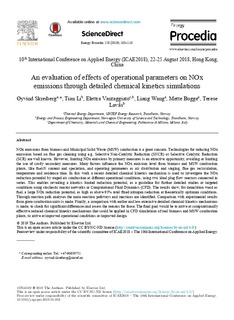| dc.contributor.author | Skreiberg, Øyvind | |
| dc.contributor.author | Li, Tian | |
| dc.contributor.author | Vantaggiato, Elettra | |
| dc.contributor.author | Wang, Liang | |
| dc.contributor.author | Bugge, Mette | |
| dc.contributor.author | Løvås, Terese | |
| dc.date.accessioned | 2019-10-11T08:53:49Z | |
| dc.date.available | 2019-10-11T08:53:49Z | |
| dc.date.created | 2019-06-07T11:31:10Z | |
| dc.date.issued | 2019 | |
| dc.identifier.citation | Energy Procedia. 2019, 158 103-110. | nb_NO |
| dc.identifier.issn | 1876-6102 | |
| dc.identifier.uri | http://hdl.handle.net/11250/2621520 | |
| dc.description.abstract | NOx emissions from biomass and Municipal Solid Waste (MSW) combustion is a great concern. Technologies for reducing NOx emissions based on flue gas cleaning using e.g. Selective Non-Catalytic Reduction (SNCR) or Selective Catalytic Reduction (SCR) are well known. However, limiting NOx emissions by primary measures is an attractive opportunity, avoiding or limiting the use of costly secondary measures. Many factors influence the NOx emission level from biomass and MSW combustion plants, like fuel-N content and speciation, and operating parameters as air distribution and staging, flue gas recirculation, temperature and residence time. In this work a recent detailed chemical kinetics mechanism is used to investigate the NOx reduction potential by staged air combustion at different operational conditions, using two ideal plug flow reactors connected in series. This enables revealing a kinetics limited reduction potential, as a guideline for further detailed studies at targeted conditions using stochastic reactor networks or Computational Fluid Dynamics (CFD). The results show, for demolition wood as fuel, a large NOx reduction potential, as high as above 95% total fixed nitrogen reduction at theoretically optimum conditions. Through reaction path analyses the main reaction pathways and reactions are identified. Comparison with experimental results from grate combustion units is made. Finally, a comparison with earlier and less extensive detailed chemical kinetics mechanisms is made, to check for significant differences and assess the reasons for those. The final goal would be to arrive at computationally effective reduced chemical kinetics mechanisms that could be applied in CFD simulations of real biomass and MSW combustion plants, to arrive at improved operational conditions or improved design. | nb_NO |
| dc.language.iso | eng | nb_NO |
| dc.publisher | Elsevier | nb_NO |
| dc.rights | Attribution-NonCommercial-NoDerivatives 4.0 Internasjonal | * |
| dc.rights.uri | http://creativecommons.org/licenses/by-nc-nd/4.0/deed.no | * |
| dc.title | An evaluation of effects of operational parameters on NOx emissions through detailed chemical kinetics simulations | nb_NO |
| dc.type | Journal article | nb_NO |
| dc.type | Peer reviewed | nb_NO |
| dc.description.version | publishedVersion | nb_NO |
| dc.source.pagenumber | 103-110 | nb_NO |
| dc.source.volume | 158 | nb_NO |
| dc.source.journal | Energy Procedia | nb_NO |
| dc.identifier.doi | 10.1016/j.egypro.2019.01.053 | |
| dc.identifier.cristin | 1703427 | |
| dc.description.localcode | © 2019 The Author(s). Published by Elsevier Ltd. © 2019 The Authors. Published by Elsevier Ltd. This is an open access article under the CC BY-NC-ND license (http://creativecommons.org/licenses/by-nc-nd/4.0/) | nb_NO |
| cristin.unitcode | 194,64,25,0 | |
| cristin.unitname | Institutt for energi- og prosessteknikk | |
| cristin.ispublished | true | |
| cristin.fulltext | original | |
| cristin.qualitycode | 0 | |

